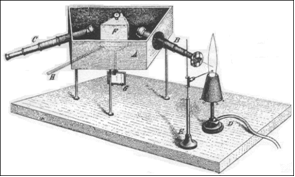- 1610: Galileo
- 1676: Ole Rømer
- 1687: Isaac Newton
- 1781: William Herschel
- 1838: Friedrich Bessel
- 1861: William and Margaret Huggins
- 1912: Henrietta Leavitt
- 1917 Einstein
- 1920: Harlow Shapley
- 1929 Edwin Hubble
- 1948: Ralph Alpher
- 1949: Fred Hoyle
- 1963: Maarten Schmidt
- 1964: Arno Penzias and Robert Wilson
- 1978: Vera Rubin and Kent Ford
- 1989: Margaret Geller and John Huchra
- 1992: John Mather and George Smoot
- 1995: Robert Williams
- 1998: Saul Perlmutter and Brian Schmidt
- 2010: Wendy Freedman
Spectroscope
Robert Bunsen is perhaps best known for his invention of a simple laboratory device, known as the Bunsen burner, familiar to every chemistry student today. Bunsen developed the burner to produce a clean-burning flame that would not contaminate samples that he wished to observe with a spectroscope. He used this device to discover several new elements.

Illustration of early Bunsen burner and spectroscope from “Chemical Analysis by Observation of Spectra” by Gustav Kirchoff and Robert Bunsen, Annalen der Physik und der Chemie (Poggendorff), Vol. 110 (1860), pp. 161-189.